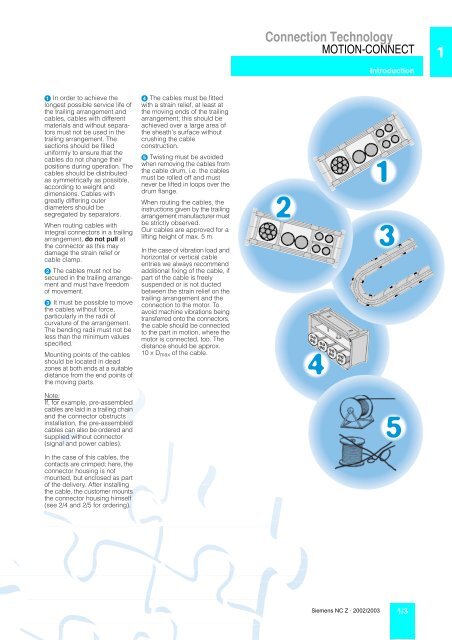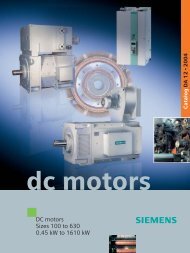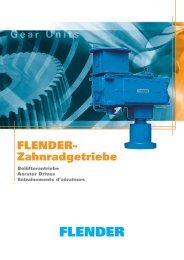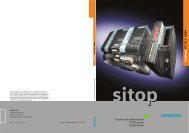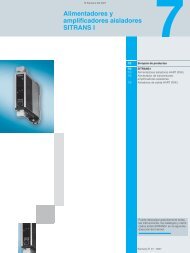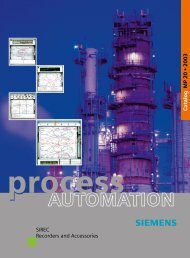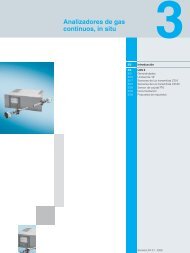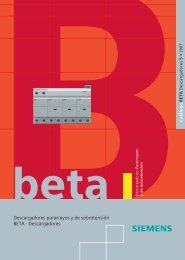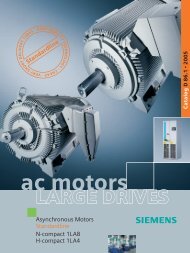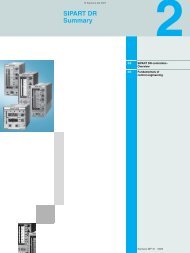Create successful ePaper yourself
Turn your PDF publications into a flip-book with our unique Google optimized e-Paper software.
a In order to achieve the<br />
longest possible service life of<br />
the trailing arrangement and<br />
cables, cables with different<br />
materials and without separators<br />
must not be used in the<br />
trailing arrangement. The<br />
sections should be filled<br />
uniformly to ensure that the<br />
cables do not change their<br />
positions during operation. The<br />
cables should be distributed<br />
as symmetrically as possible,<br />
according to weight and<br />
dimensions. <strong>Cables</strong> with<br />
greatly differing outer<br />
diameters should be<br />
segregated by separators.<br />
When routing cables with<br />
integral connectors in a trailing<br />
arrangement, do not pull at<br />
the connector as this may<br />
damage the strain relief or<br />
cable clamp.<br />
s The cables must not be<br />
secured in the trailing arrangement<br />
and must have freedom<br />
of movement.<br />
d It must be possible to move<br />
the cables without force,<br />
particularly in the radii of<br />
curvature of the arrangement.<br />
The bending radii must not be<br />
less than the minimum values<br />
specified.<br />
Mounting points of the cables<br />
should be located in dead<br />
zones at both ends at a suitable<br />
distance from the end points of<br />
the moving parts.<br />
Note:<br />
If, for example, pre-<strong>assembled</strong><br />
cables are laid in a trailing chain<br />
and the connector obstructs<br />
installation, the pre-<strong>assembled</strong><br />
cables can also be ordered and<br />
supplied without connector<br />
(signal and power cables).<br />
In the case of this cables, the<br />
contacts are crimped; here, the<br />
connector housing is not<br />
mounted, but enclosed as part<br />
of the delivery. After installing<br />
the cable, the customer mounts<br />
the connector housing himself<br />
(see 2/4 and 2/5 for ordering).<br />
f The cables must be fitted<br />
with a strain relief, at least at<br />
the moving ends of the trailing<br />
arrangement; this should be<br />
achieved over a large area of<br />
the sheath’s surface without<br />
crushing the cable<br />
construction.<br />
g Twisting must be avoided<br />
when removing the cables from<br />
the cable drum, i.e. the cables<br />
must be rolled off and must<br />
never be lifted in loops over the<br />
drum flange.<br />
When routing the cables, the<br />
instructions given by the trailing<br />
arrangement manufacturer must<br />
be strictly observed.<br />
Our cables are approved for a<br />
lifting height of max. 5 m.<br />
In the case of vibration load and<br />
horizontal or vertical cable<br />
entries we always recommend<br />
additional fixing of the cable, if<br />
part of the cable is freely<br />
suspended or is not ducted<br />
between the strain relief on the<br />
trailing arrangement and the<br />
connection to the motor. To<br />
avoid machine vibrations being<br />
transferred onto the connectors,<br />
the cable should be connected<br />
to the part in motion, where the<br />
motor is connected, too. The<br />
distance should be approx.<br />
10 x Dmax of the cable.<br />
Connection Technology<br />
MOTION-CONNECT<br />
Siemens NC Z · 2002/2003<br />
Introduction<br />
1/3<br />
1


